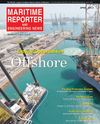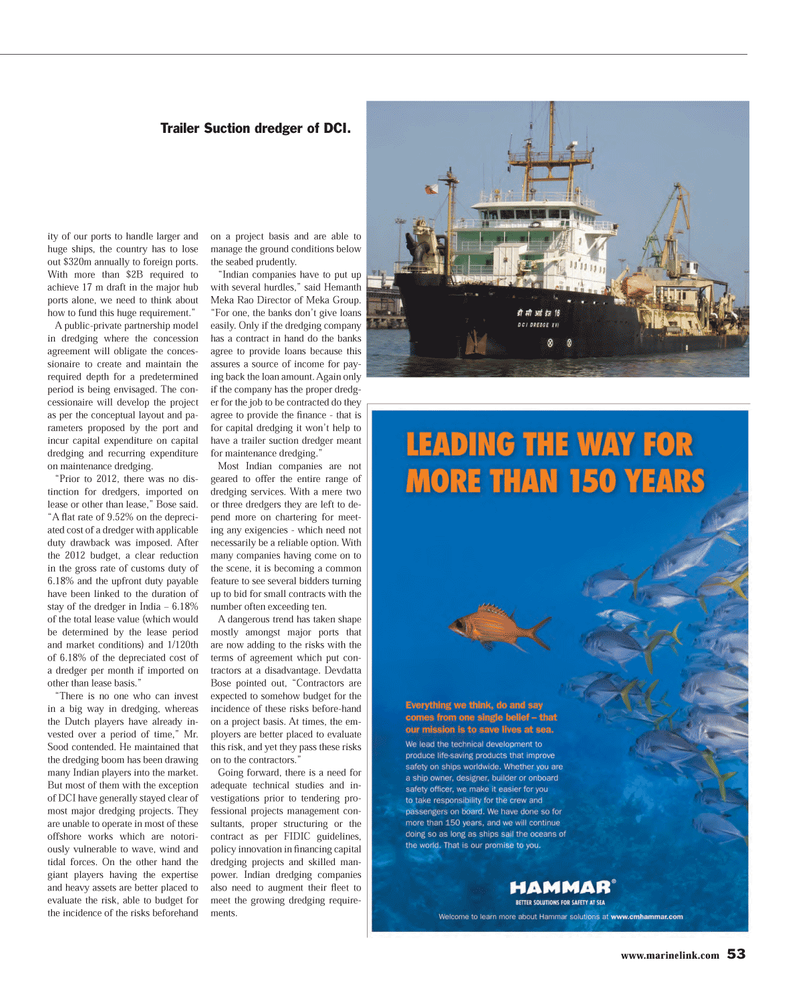
Page 53: of Maritime Reporter Magazine (April 2013)
Offshore Energy Edition
Read this page in Pdf, Flash or Html5 edition of April 2013 Maritime Reporter Magazine
www.marinelink.com 53ity of our ports to handle larger and huge ships, the country has to lose out $320m annually to foreign ports. With more than $2B required to achieve 17 m draft in the major hub ports alone, we need to think about how to fund this huge requirement.?A public-private partnership model in dredging where the concession agreement will obligate the conces-sionaire to create and maintain the required depth for a predetermined period is being envisaged. The con- cessionaire will develop the project as per the conceptual layout and pa-rameters proposed by the port and incur capital expenditure on capital dredging and recurring expenditure on maintenance dredging.?Prior to 2012, there was no dis-tinction for dredgers, imported on lease or other than lease,? Bose said. ?A ß at rate of 9.52% on the depreci-ated cost of a dredger with applicable duty drawback was imposed. After the 2012 budget, a clear reduction in the gross rate of customs duty of 6.18% and the upfront duty payable have been linked to the duration of stay of the dredger in India ? 6.18% of the total lease value (which would be determined by the lease period and market conditions) and 1/120th of 6.18% of the depreciated cost of a dredger per month if imported on other than lease basis.? ?There is no one who can invest in a big way in dredging, whereas the Dutch players have already in-vested over a period of time,? Mr. Sood contended. He maintained that the dredging boom has been drawing many Indian players into the market. But most of them with the exception of DCI have generally stayed clear of most major dredging projects. They are unable to operate in most of these offshore works which are notori- ously vulnerable to wave, wind and tidal forces. On the other hand the giant players having the expertise and heavy assets are better placed to evaluate the risk, able to budget for the incidence of the risks beforehand on a project basis and are able to manage the ground conditions below the seabed prudently. ?Indian companies have to put up with several hurdles,? said Hemanth Meka Rao Director of Meka Group. ?For one, the banks don?t give loans easily. Only if the dredging company has a contract in hand do the banks agree to provide loans because this assures a source of income for pay-ing back the loan amount. Again only if the company has the proper dredg-er for the job to be contracted do they agree to provide the Þ nance - that is for capital dredging it won?t help to have a trailer suction dredger meant for maintenance dredging.?Most Indian companies are not geared to offer the entire range of dredging services. With a mere two or three dredgers they are left to de-pend more on chartering for meet-ing any exigencies - which need not necessarily be a reliable option. With many companies having come on to the scene, it is becoming a common feature to see several bidders turning up to bid for small contracts with the number often exceeding ten.A dangerous trend has taken shape mostly amongst major ports that are now adding to the risks with the terms of agreement which put con-tractors at a disadvantage. Devdatta Bose pointed out, ?Contractors are expected to somehow budget for the incidence of these risks before-hand on a project basis. At times, the em- ployers are better placed to evaluate this risk, and yet they pass these risks on to the contractors.?Going forward, there is a need for adequate technical studies and in-vestigations prior to tendering pro-fessional projects management con-sultants, proper structuring or the contract as per FIDIC guidelines, policy innovation in Þ nancing capital dredging projects and skilled man-power. Indian dredging companies also need to augment their ß eet to meet the growing dredging require-ments.Trailer Suction dredger of DCI. MR #4 (50-57).indd 53MR #4 (50-57).indd 534/2/2013 4:38:48 PM4/2/2013 4:38:48 PM

 52
52

 54
54
